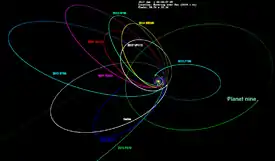2013 RF98
2013 RF98 is a trans-Neptunian object.[2] It was discovered on September 12, 2013, at Cerro Tololo-DECam.
| Discovery[1] | |
|---|---|
| Discovered by | Dark Energy Survey (807) |
| Discovery date | 12 September 2013 |
| Designations | |
Designation | 2013 RF98 |
| TNO | |
| Orbital characteristics[2] | |
| Epoch 16 February 2017 (JD 2457800.5) | |
| Uncertainty parameter 5 | |
| Observation arc | 1092 days (2.99 yr) |
| Aphelion | 662 ± 20 AU (Q) 690 AU (barycentric)[3] |
| Perihelion | 36.09 0.03 AU (q) |
| 349 ± 11 AU 364 AU (barycentric)[3] | |
| Eccentricity | 0.897 ± 0.003 |
| 6527 ± 299 yr 6900 yr (barycentric solution)[3] | |
| 0.404° ± 0.004° | |
| Inclination | 29.572° ± 0.003° |
| 67.596° ± 0.005° | |
| 311.8° ± 0.6° | |
| Physical characteristics | |
| Dimensions | ~50-120 km |
Spectral type | Blue[4] |
| 24.4 (2016) 28.8 (@100AU) | |
| 8.7 ± 0.3[2] | |
It is part of the evidence for the Planet Nine hypothesis because it shares a similar argument of perihelion with other potentially shepherded TNOs.
Discovery, orbit and physical properties

2013 RF98 was discovered by the Dark Energy Survey on September 12, 2013, observing with the 4 m Blanco Telescope from Cerro Tololo Inter-American Observatory.[1] Its orbit is characterized by high eccentricity (0.897), moderate inclination (29.57º) and a semi-major axis of 349 AU.[1] Upon discovery, it was classified as a trans-Neptunian object. Its orbit is relatively well determined; as of January 11, 2017 its orbital solution is based on 51 observations spanning a data-arc of 1092 days.[2] 2013 RF98 has an absolute magnitude of 8.7 which gives a characteristic diameter of 50 to 120 km for an assumed albedo in the range 0.25–0.05.[5]
It came to perihelion (closest approach to the Sun) around October 2009 and was last observed in September 2016.[2] As of October 2016, it is 36.6 AU from the Sun. Of the seven objects whose aligned orbits suggest the existence of Planet Nine, it is currently the closest to the Sun. It will be 18.7 AU from Uranus in 2021. It will be in the constellation of Cetus until 2022. It comes to opposition at the start of November.
2013 RF98's orbit is similar to that of 474640 Alicanto, suggesting that they may have both been thrown onto their current paths by the same body, or that they may have been the same object (single or binary) at one point. Its spectral slope is also similar to that of 474640 Alicanto.[4][6]
2013 RF98's visible spectrum is very different from that of 90377 Sedna.[4][7] The value of its spectral slope suggests that the surface of this object can have pure methane ices (like in the case of Pluto) and highly processed carbons, including some amorphous silicates.[4]
See also
- 90377 Sedna (relatively large and also distant body)
- List of Solar System objects by greatest aphelion
References
- "List Of Centaurs and Scattered-Disk Objects". Minor Planet Center. Retrieved 22 January 2016.
- "JPL Small-Body Database Browser: (2013 RF98)" (last observation: 2016-10-08; arc: 1092 days). Jet Propulsion Laboratory. Archived from the original on 25 January 2016. Retrieved 22 October 2016.
- Horizons output. "Barycentric Osculating Orbital Elements for 2013 RF98". Retrieved 8 February 2017. (Ephemeris Type:Elements and Center:@0)
- de León, Julia; de la Fuente Marcos, Carlos; de la Fuente Marcos, Raúl (May 2017). "Visible spectra of (474640) 2004 VN112-2013 RF98 with OSIRIS at the 10.4 m GTC: evidence for binary dissociation near aphelion among the extreme trans-Neptunian objects". Monthly Notices of the Royal Astronomical Society: Letters. 467 (1): L66–L70. arXiv:1701.02534. Bibcode:2017MNRAS.467L..66D. doi:10.1093/mnrasl/slx003. S2CID 119419889.
- "ABSOLUTE MAGNITUDE (H)". NASA/JPL. Archived from the original on 2 March 2001. Retrieved 28 February 2008.
- de la Fuente Marcos, C.; de la Fuente Marcos, R.; Aarseth, S. J. (1 November 2017). "Binary stripping as a plausible origin of correlated pairs of extreme trans-Neptunian objects". Astrophysics and Space Science. 362 (11): 198 (18pp.). arXiv:1709.06813. Bibcode:2017Ap&SS.362..198D. doi:10.1007/s10509-017-3181-1. S2CID 118890903.
- "JPL Small-Body Database Browser: 90377 Sedna (2003 VB12)". Retrieved 28 March 2014.
External links
- Archive of JPL #2 Epoch 2016-Jan-13 with 56-day observation arc
- MPEC 2016-U18: 2013 RF98
- New data about two distant asteroids give a clue to the possible “Planet Nine”
- Dos asteroides lejanos apoyan la hipótesis del Planeta Nueve
- 2013 RF98 at AstDyS-2, Asteroids—Dynamic Site
- 2013 RF98 at the JPL Small-Body Database


